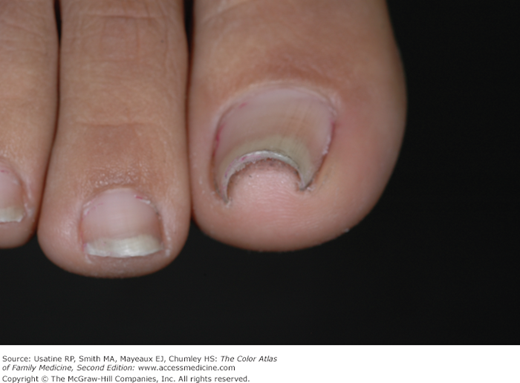Patient Story
A 14-year-old boy presents with a history of multiple ingrown nails of both great toes. Today his right big toe is swollen and painful (Figure 192-1). He has a 2-week history of pain, redness, and swelling of the lateral nail fold of the right great toe. Soaking the toe in Epsom salts has not helped. A partial nail removal after a digital block was successful. The nail matrix was also ablated with phenol to prevent recurrence of the ingrown nail.
Introduction
Epidemiology
Etiology and Pathophysiology
Onychocryptosis occurs when the lateral nail plate damages the lateral nail fold. The lateral edge of the nail plate penetrates and perforates the adjacent nailfold skin. Perforation of the lateral fold skin results in painful inflammation that manifests clinically as mild edema, erythema, and pain. In advanced stages, drainage, infection, and ulceration may be present. Hypertrophy of the lateral nail wall occurs, and granulation tissue forms over the nail plate and the nailfold during healing of the ulcerated skin.1 It is a common affliction that can result from a variety of conditions that cause improper fit of the nail plate in the lateral nail groove (Figure 192-1).
Risk Factors
- Genetic predisposition.
- Poor-fitting footwear.
- Excessive trimming of the lateral nail plate.
- Pincer nail deformity (Figure 192-2).
- Trauma.
- Sports in which kicking or running is important.
- Hyperhidrosis.
- Anatomic features such as nailfold width.
- Congenital malalignment of the digit.
- Overcurvature of the nail plate.
- Onychomycosis and other diseases that result in abnormal changes in the nail plate.
Diagnosis
The diagnosis is based upon clinical appearance and rarely is difficult. Characteristic signs and symptoms include pain, edema, exudate, and granulation tissue (Figure 192-1).
Differential Diagnosis
Stay updated, free articles. Join our Telegram channel

Full access? Get Clinical Tree




